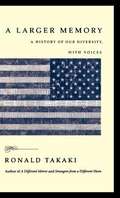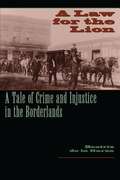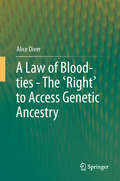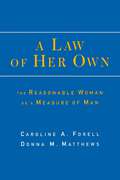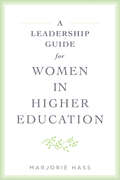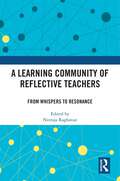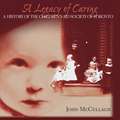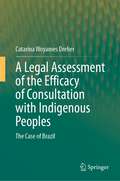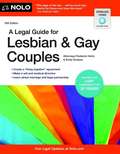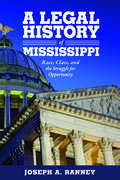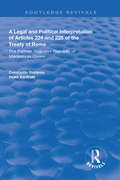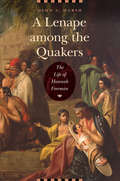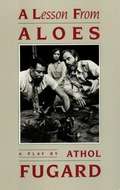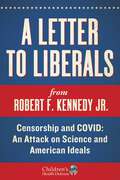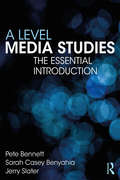- Table View
- List View
A Language and Power Reader
by Robert Eddy Victor VillanuevaA Language and Power Reader organizes reading and writing activities for undergraduate students, guiding them in the exploration of racism and cross-racial rhetorics.Introducing texts written from and about versions of English often disrespected by mainstream Americans, A Language and Power Reader highlights English dialects and discourses to provoke discussions of racialized relations in contemporary America. Thirty selected readings in a range of genres and from writers who work in "alternative" voices (e.g., Pidgin, African American Language, discourse of international and transnational English speakers) focus on disparate power relations based on varieties of racism in America and how those relations might be displayed, imposed, or resisted across multiple rhetorics. The book also directs student participation and discourse. Each reading is followed by comments and guides to help focus conversation, and each guide includes an invitation to dialogue with the editors about specific questions on Facebook. Research has long shown that increasing a student's metalinguistic awareness improves a student's writing. No other reader available at this time explores the idea of multiple rhetorics or encourages their use. A Language and Power Reader will be a welcome addition to writing classrooms and will be of interest to students of sociology, ethnic studies, and American studies.
A Lapidary of Sacred Stones: Their Magical and Medicinal Powers Based on the Earliest Sources
by Claude LecouteuxA comprehensive dictionary of sacred and magical gem lore that draws on the rarest source texts of Antiquity and the Middle Ages • Reveals the healing and magical virtues of familiar gemstones, such as amethyst, emerald, and diamond, as well as the lore surrounding exotic stones such as astrios, a stone celebrated by ancient magicians • Examines bezoars (stones formed in animals’ bodies) and “magnets” that attract materials other than metal • Based on ancient Arabic, Greek, Jewish, and European sources, ranging from the observations of Pliny the Elder to extremely rare texts such as the Picatrix and Damigeron’s Virtue of Stones Our ancestors believed stones were home to sacred beings of power, entities that if properly understood and cultivated could provide people protection from ill fortune, envy, and witchcraft; grant invisibility and other magical powers; improve memory; and heal the sick from a wide variety of diseases. These benefits could be obtained by wearing the stone on a ring, bracelet, or pendant; through massage treatments with the stone; or by reducing the gem into a powder and drinking it mixed with water or wine. Drawing from a wealth of ancient Arabic, Greek, Jewish, and European sources--from the observations of Pliny the Elder to extremely rare texts such as the Picatrix and Damigeron’s Virtue of Stones--Claude Lecouteux provides a synthesis of all known lore for more than 800 stones. He includes such common examples as the emerald, which when engraved with the figure of a harpy holding a lamprey in its claws will banish panic and nightmares, and beryl, which when appropriately carved can summon water spirits or win its owner high renown, as well as more exotic stones such as astrios, a stone celebrated by ancient magicians and whose center glows like a star. Lecouteux also examines bezoars--stones formed in animals’ bodies--as well as “magnets” that attract materials other than iron, such as gold, flesh, cotton, or scorpions. This comprehensive dictionary of sacred and magical gem lore, drawn from the rarest sources of Antiquity and the Middle Ages, represents a one-of-a-kind resource for gem enthusiasts and magical practitioners alike.
A Larger Memory: A History of Our Diversity, with Voices
by Ronald T. TakakiOne of the country's premier multi-culturalist scholars, Takaki eschews the angry, jargon-ridden ideological polemics that make up the usual artillery of the curriculum wars, opting instead to let America's diverse peoples speak for themselves in excerpts that are both informative and moving. While a few pieces are by familiar figures such as Frederick Douglass and Black Elk, most are by "ordinary" people -- African, Latino, Native American, Irish, Chinese, Jewish, Japanese, Polish, Mexican, Italian, Caribbean, Indian, Puerto Rican, Korean -- who recount their struggles and aspirations eloquently and with dignity.
A Last Kiss for Mummy: A Teenage Mum, A Tiny Infant, A Terrible Choice
by Casey WatsonAt fourteen, Emma is just a child herself - and one who's never been properly mothered. She has been in foster care several times already and when she discovered she was pregnant, and refused to have an abortion, her mother threw her out of the house. Casey and her family instantly form a strong bond with Emma's baby Roman, but dealing with Emma's behaviour and constant lack of responsibility is a far tougher challenge. And before long Casey finds she's doing something she never thought she would - covering up for Emma's shortcomings as she allows her personal involvement to colour her judgement. But the more Casey gets to know Emma the more she's convinced that with the right help and guidance this lonely and unsupported girl can become a good mother to her gorgeous little boy. That's what makes it even harder when Casey and her family have to make a stark choice: to hold on to Emma or look after Roman; to help a teenage girl desperate to turn her life around, or offer an innocent baby a safe home and much-needed good start in life.
A Law Unto Herself: A Novel (Legacies of Nineteenth-Century American Women Writers)
by Rebecca Harding Davis Alicia Mischa RenfroeA scathing critique of the legal status of women and their property rights in nineteenth-century America, Rebecca Harding Davis’s 1878 novel A Law Unto Herself chronicles the experiences of Jane Swendon, a seemingly naïve and conventional nineteenth-century protagonist struggling to care for her elderly father with limited financial resources. In order to continue care, Jane seeks to secure her rightful inheritance despite the efforts of her cousin and later her husband, a greedy man who has tricked her father into securing her hand in marriage. Appealing to middle-class literary tastes of the age, A Law Unto Herself elucidated for a broad general audience the need for legal reforms regarding divorce, mental illness, inheritance, and reforms to the Married Women’s Property Laws. Through three fascinating female characters, the novel also invites readers to consider evolving gender roles during a time of cultural change.
A Law for the Lion: A Tale of Crime and Injustice in the Borderlands
by Beatriz de la Garza"Esto no es cosa de armas" (this is not a matter for weapons). These were the last words of Don Francisco Gutiérrez before Alonzo W. Allee shot and killed him and his son, Manuel Gutiérrez. What began as a simple dispute over Allee's unauthorized tenancy on a Gutiérrez family ranch near Laredo, Texas, led not only to the slaying of these two prominent Mexican landowners but also to a blatant miscarriage of justice.<P><P>In this engrossing account of the 1912 crime and the subsequent trial of Allee, Beatriz de la Garza delves into the political, ethnic, and cultural worlds of the Texas-Mexico border to expose the tensions between the Anglo minority and the Mexican majority that propelled the killings and their aftermath. Drawing on original sources, she uncovers how influential Anglos financed a first-class legal team for Allee's defense and also discusses how Anglo-owned newspapers helped shape public opinion in Allee's favor. In telling the story of this long-ago crime and its tragic results, de la Garza sheds new light on the interethnic struggles that defined life on the border a century ago, on the mystique of the Texas Rangers (Allee was said to be a Ranger), and on the legal framework that once institutionalized violence and lawlessness in Texas.
A Law of Blood-ties - The 'Right' to Access Genetic Ancestry: The 'right' To Access Genetic Ancestry
by Alice DiverThis text collates and examines the jurisprudence that currently exists in respect of blood-tied genetic connection, arguing that the right to identity often rests upon the ability to identify biological ancestors, which in turn requires an absence of adult-centric veto norms. It looks firstly to the nature and purpose of the blood-tie as a unique item of birthright heritage, whose socio-cultural value perhaps lies mainly in preventing, or perhaps engendering, a feared or revered sense of 'otherness.' It then traces the evolution of the various policies on 'telling' and accessing truth, tying these to the diverse body of psychological theories on the need for unbroken attachments and the harms of being origin deprived. The 'law' of the blood-tie comprises of several overlapping and sometimes conflicting strands: the international law provisions and UNCRC Country Reports on the child's right to identity, recent Strasbourg case law, and domestic case law from a number of jurisdictions on issues such as legal parentage, vetoes on post-adoption contact, court-delegated decision-making, overturned placements and the best interests of the relinquished child. The text also suggests a means of preventing the discriminatory effects of denied ancestry, calling upon domestic jurists, legislators, policy-makers and parents to be mindful of the long-term effects of genetic 'kinlessness' upon origin deprived persons, especially where they have been tasked with protecting this vulnerable section of the population.
A Law of Her Own: The Reasonable Woman as a Measure of Man
by Caroline Forell Donna MatthewsDespite the apparent progress in women's legal status, the law retains a profoundly male bias, and as such contributes to the pervasive violence and injustice against women. In A Law of Her Own, the authors propose to radically change law's fundamental paradigm by introducing a "reasonable woman standard" for measuring men's behavior. Advocating that courts apply this standard to the conduct of men-and women-in legal settings where women are overwhelmingly the injured parties, the authors seek to eliminate the victimization and objectification of women by dismantling part of the legal structure that supports their subordination. A woman-based legal standard-focusing on respect for bodily integrity, agency, and autonomy-would help rectify the imbalance in how society and its legal system view sexual and gender-based harassment, rape, stalking, battery, domestic imprisonment, violence, and death. Examining the bias of the existing "reasonable person" standard through analysis of various court cases and judicial decisions, A Law of Her Own aims to balance the law to incorporate women's values surrounding sex and violence.
A Leadership Guide for Women in Higher Education
by Marjorie HassWomen face unique challenges as they move into senior leadership roles at colleges and universities. This guide provides them with the frank, supportive advice they need to advance their careers and lead with excellence.For years, Marjorie Hass, now the president of Rhodes College, was approached by women in higher education looking for advice and support as they took on leadership roles and navigated challenging career paths. Eventually, she began offering online seminars so she could meet in small groups to answer questions and encourage women to develop mutually supportive relationships. In A Leadership Guide for Women in Higher Education, Hass draws on her sixteen years of senior leadership experience, her work with national higher education organizations, and her mentorship work with dozens of women to address fundamental issues women face when they lead in higher education.Aiming to level the playing field by giving women the insightful, supportive advice they need to advance in their careers and to lead with excellence, Hass combines practical information with career coaching. In this frank guide to launching, building, and advancing your academic career, Hass addresses a wide range of topics, including• deciding whether academic leadership is for you• developing a personal leadership style• becoming comfortable with power, ambition, and personal voice• navigating patriarchal assumptions• finding joy in leadership work• gaining experience with budget management, revenue generation, personnel management, and fund-raising—no matter your current job title• effectively managing conflict• aligning personal and career values and goals• winning your next job• and much moreWomen at any stage of their academic leadership career will find this guide insightful, useful, and empowering, as will anyone interested in supporting women leaders and diversifying leadership in higher education.
A Learning Community of Reflective Teachers: From Whispers to Resonance
by Neeraja RaghavanTeachers possess a wealth of untapped wisdom and valuable experience. Whether it’s in matter of educational policy, curriculum development or textbook selection, teachers carry a trove of information and insights to share. Traditionally, teacher development has been driven by administrators of schools, and it often takes the form of a ‘mentor’ teaching the staff of a school. But what happens when teachers across different locations collaborate and learn together? This volume documents such an initiative, sparked off by the Covid-19 pandemic, which brought people together online. It underscores the power of teachers debating, discussing, and learning from each other. Based on an Indian experience, the book addresses a range of issues teachers and educators face across the world — encompassing pedagogy, classroom management, school culture and teacher development. A unique story of community building and teacher education, this book also contains key outcomes and insights which take us through their action research projects and showcases a model of teacher development that can be adopted by interested readers. Above all, it brings out the crying need for a teacher’s voice to be heard — for far too long, teachers have been mere implementers of decisions taken by policy makers or managements of schools. By means of networking communities such as the one described in this book, the transformation of teachers going from whispers to resonance is greatly amplified. An important intervention in the domain of teacher development, this volume will be of great interest to students, researchers and practitioners of education, teacher education, and sociology of education. It will also be useful for teacher trainees, academicians, teacher educators, policymakers, schoolteachers, curriculum developers, teacher training institutes, and universities offering teacher education programs.
A Lebanon Defied: Musa Al-sadr And The Shi'a Community
by Majed HalawiA Lebanon Defied focuses on the constitutive role of the Shi'a masses in the movement led by Sayyid Musa al-Sadr in Lebanon. It explores the origins of this Shi'a movement and its determination to become a major participant in a sharply reformed Lebanese polity. .
A Legacy of Caring: A History of the Children's Aid Society of Toronto
by Children'S Aid Foundation Gail Aitken Donald F. Bellamy John MccullaghBegun in 1891, the Children’s Aid Society of Toronto is the largest child welfare agency in North America. It has played a leading roll as an advocate of children’s welfare; it has been instrumental in influencing child welfare practice not only in Ontario but all of Canada and elsewhere. With an emphasis on the post-World War II period, A Legacy of Caring examines the political, social, and economic factors that led to changes within the society itself as well as developments in legislation and social policy. The society has been a training ground for many highly committed professionals who have gone on to be leaders in other governmental and nongovernmental agencies in Canada and abroad.
A Legal Assessment of the Efficacy of Consultation with Indigenous Peoples: The Case of Brazil
by Catarina Woyames DreherThis book offers a novel perspective on consultation with indigenous peoples in projects of natural resource exploitation. Engaging with current debates in international law, the study introduces a multi-dimensional perspective on consultation understood to include self-determination and cultural rights. It analyzes evidence from several countries across the Americas and Africa and presents an original and in-depth case study of Brazil. The book assesses judicial and legislative cases, drawing on relevant literature, international treaties and supplementary information gained from expert interviews. This supports the work’s broader objective to explore legal facts as well as to evaluate the empirical evidence in light of theoretical considerations. It thereby expands the understanding of consultation as a right under national legal systems and considers practical ways on how to enforce domestic redress for avoiding legal indeterminacy. The conclusions of the analysis contribute to not only a better understanding of the subject matter but also showcase ways of how to improve the realities on the ground. The book puts forward a range of recommendations directed at national authorities, international organizations, development lenders and civil society to help improve the unsatisfactory present circumstances. The intended audience encompasses legal scholars, students, practitioners and journalists, as well as anyone interested in research on the realization of indigenous peoples’ rights and the role of international law in the 21st century.
A Legal Guide for Lesbian and Gay Couples
by Denis Clifford Emily Doskow Frederick HertzProtect your rights -- protect your relationship. Laws affecting LGBT couples are changing rapidly, and while its an exciting time for all gay and lesbian partners, keeping up with the myriad ways the shifting legal landscape touches your family life can be daunting. Now more than ever, its important that you take the proper legal steps to define and protect your relationship in the eyes of the law. If you dont, you run the risk of being shut out of each others lives -- and the lives of children you co- parent -- in times of medical, financial or personal crisis. Fortunately, this practical guide is updated with the latest legal information and legislation that will help you and your same-sex partner protect and exercise your rights, and make sound decisions as a couple. A Legal Guide for Lesbian & Gay Couples covers these important subjects, and many more: . making practical decisions about living together . planning for medical emergencies -- making medical decisions for one another and taking care of each others finances when one partner is incapacitated . domestic partner benefits and how to obtain them . buying property together . providing for each other upon death . practical and legal aspects of having and raising children . marriage laws for all 50 states The updated edition of A Legal Guide for Lesbian & Gay Couples is updated to provide the latest information on same-sex marriage, civil unions and domestic partnerships in the U. S. , Canada and around the world, as well as all the recent developments in same- sex partnership law. Plus, create essential legal documents using the step-by-step instructions included. --Download forms for book at nolo. com
A Legal History of Adoption in Ontario. 1921-2015
by Lori Chambers The Osgoode SocietyLori Chambers' fascinating study explores the legal history of adoption in Ontario since the passage of the first statute in 1921. This volume explores a wide range of themes and issues in the history of adoption including: the reasons for the creation of statutory adoption, the increasing voice of unmarried fathers in newborn adoption, the reasons for movement away from secrecy in adoption, the evolution of step-parent adoption, the adoption of Indigenous children, and the growth of international adoption. Unlike other works on adoption, Chambers focuses explicitly on statutes, statutory debates and the interpretation of statues in court. In doing so, she concludes that adoption is an inadequate response to child welfare and on its own cannot solve problems regarding child neglect and abuse. Rather, Chambers argues that in order to reform the area of adoption we must first acknowledge that it is built upon social inequalities within and between nations.
A Legal History of Mississippi: Race, Class, and the Struggle for Opportunity
by Joseph A. RanneyIn A Legal History of Mississippi: Race, Class, and the Struggle for Opportunity, legal scholar Joseph A. Ranney surveys the evolution of Mississippi’s legal system and analyzes the ways in which that system has changed during the state’s first two hundred years. Through close research, qualitative analysis, published court decisions, statutes, and law review articles, along with unusual secondary sources including nineteenth-century political and legal journals and journals of state constitutional conventions, Ranney indicates how Mississippi law has both shaped and reflected the state’s character and, to a certain extent, how Mississippi’s legal evolution compares with that of other states.Ranney examines the interaction of Mississippi law and society during key periods of change including the colonial and territorial eras and the early years of statehood when the legal foundations were laid; the evolution of slavery and slave law in Mississippi; the state’s antebellum role as a leader of Jacksonian legal reform; the unfolding of the response to emancipation and wartime devastation during Reconstruction and the early Jim Crow era; Mississippi’s legal evolution during the Progressive Era and its legal response to the crisis of the Great Depression; and the legal response to the civil rights revolution of the mid-twentieth century and the cultural revolutions of the late twentieth century. Histories of the law in other states are starting to appear, but there is none for Mississippi. Ranney fills that gap to help us better understand the state as it enters its third century.
A Legal and Political Interpretation of Articles 224 and 225 of the Treaty of Rome: The Former Yugoslav Republic of Macedonia Cases (Routledge Revivals)
by Helen Xanthaki Constantin StefanouFirst published in 1997. Article 224 is one of the most powerful Articles of the Treaty of Rome, allowing a member state to take unilateral measures and to suspend some or all its Treaty-based obligations in times of what can loosely be described as serious internal turmoil or external threat. It is for this reason that the very next Article of the Treaty, Article 225, allows the Commission or a member state to challenge invocation of Art.224, before the European Court of Justice (ECJ), on grounds of improper use. In practice, the use of Art.224, by a member state presents multiple problems. The obvious connection with defence and security issues has inhibited the ECJ which still has not given and authentic interpretation of this Article. As the recent former Yugoslav Republic of Macedonia (FYROM) cases (Greek referral for the embargo on FYROM) indicate, unless the use of Art.224 is blatantly flippant, the ECJ is not in a position to challenge a member state’s unilateral measures.
A Lenape among the Quakers: The Life of Hannah Freeman
by Dawn G. MarshOn July 28, 1797, an elderly Lenape woman stood before the newly appointed almsman of Pennsylvania’s Chester County and delivered a brief account of her life. In a sad irony, Hannah Freeman was establishing her residency—a claim that paved the way for her removal to the poorhouse. Ultimately, however, it meant the final removal from the ancestral land she had so tenaciously maintained. Thus was William Penn’s “peaceable kingdom” preserved. A Lenape among the Quakers reconstructs Hannah Freeman’s history, traveling from the days of her grandmothers before European settlement to the beginning of the nineteenth century. The story that emerges is one of persistence and resilience, as “Indian Hannah” negotiates life with the Quaker neighbors who employ her, entrust their children to her, seek out her healing skills, and, when she is weakened by sickness and age, care for her. And yet these are the same neighbors whose families have dispossessed hers. Fascinating in its own right, Hannah Freeman’s life is also remarkable for its unique view of a Native American woman in a colonial community during a time of dramatic transformation and upheaval. In particular it expands our understanding of colonial history and the Native experience that history often renders silent.
A Lesbian Love Advisor
by Celeste WestWitty, yet also serious content, for lesbians and relationships. Some wonderful ideas and examples for various types of rituals.
A Less Boring History of the World
by Dave RearRefreshes the parts other history books can’t reach...A bit ropy on the Renaissance?In the dark about the Enlightenment?Or, in fact, do you need a revision course on the entire history of the world and want to read a witty, irreverent, definitely not boring romp through everything that has ever happened on planet earth – from 15 billion years BC to the present day? Good.A Less Boring History of the World tells you everything you need to know from the Big Bang to Barack Obama, taking in the Byzantines, the Black Death, Bin Laden and the fall of bankers along the way, all boiled down to bite size chunks so that you can finally piece together all the different bits of history - and see how on earth we ended up in the mess we are today. A Less Boring History refreshes your memory and broadens your mind. And, if that’s not enough, it will also make you laugh. A lot.
A Lesson from Aloes
by Athol FugardTwo former political activists confront each other and the events which led to their sudden falling-out years ago.
A Letter to Liberals: Censorship and COVID: An Attack on Science and American Ideals (Children’s Health Defense)
by Robert F. Kennedy Jr.A leading Democrat challenges his party to return to liberal values and evidence-based science Democrats were the party of intellectual curiosity, critical thinking, and faith in scientific and liberal empiricism. They once took pride in understanding how to read science critically, exercising healthy skepticism toward notoriously corrupt entities like the drug companies that brought us the opioid crisis, and were outraged by the phenomenon of &“agency capture&” and the pervasive control of private interests over Congress, the media, and the scientific journals. During the COVID pandemic, these attitudes have taken a back seat to blind faith in government mandates and countermeasures driven by pharmaceutical companies and captive federal agencies, promoted by corporate media, and cynically exploiting the fears of the American people. A Letter to Liberals is Robert F. Kennedy Jr.&’s, challenge to &“lockdown liberalism&’s&” embrace of policies that are an affront to once cherished precepts. Kennedy invites readers to look at the data in order to answer questions such as:Did COVID vaccines really save millions and end the pandemic?Why were the lowest COVID death rates in countries and states that relied on therapeutic drugs, and in countries with the lowest vaccination rates?Did vaccines prevent infection or transmission as officials promised?Why do COVID vaccines appear to show &“negative efficacy&”—making the vaccinated more susceptible to COVID.Why does the most reliable data suggest that COVID vaccines do not lower the risk of death and hospitalization.Should government technocrats be partnering with media and social media titans to censor and suppress the questioning of government policies?And why have so many liberals abandoned fundamental Constitutional principles in their headlong rush to embrace pandemic policies pushed by captured bureaucrats, feckless politicians, a compromised news media, and Big Pharma?In his November 2021 book The Real Anthony Fauci, which sold over 1,000,000 copies, Kennedy made predictions that have matured from &“conspiracy theories&” to proven facts. Among these: Masks Are Ineffective and DangerousSocial Distancing Was Not Science-BasedSchool Closures Were Not Science-BasedLockdowns Were CounterproductiveVaccinating Children Causes More Harm and Death Than It AvertsOfficials Wrongly Used PCR Tests to Justify the CountermeasuresCOVID-19 May Have Come from Wuhan LabNatural Immunity is Superior to Vaccine Immunity Kennedy throws down the gauntlet for the kind of vigorous scientific debate that liberals have long stood for and strives to ensure that unbiased honesty and well-researched thought is brought to bear on one of the most important and still unfolding chapters in human history.
A Letter to My White Friends and Colleagues: What You Can Do Right Now to Help the Black Community
by Steven S. RogersLearn how to address racial wealth disparity in the United States today From the life, professional experiences, and research of former Harvard Business School professor Steven Rogers, comes his boldly stated, A Letter to My White Friends and Colleagues. This informative epistle investigates the causes of racial wealth disparity in the United States and provides solutions for addressing it. Through extensive data and historical research, anecdotes, teaching, and case studies, it presents practical ways White people can work with and help the Black community. It teaches readers that eliminating the $153,000 wealth gap between Black and White people is the solution to over 75% of our problems and offers solutions to help improve Black-White racial relations in the United States. In straightforward language, filled with facts, stories, advice, and sometimes even humor, A Letter to My White Friends and Colleagues encourages every White person to share his/her wealth with the Black community—plain and simple. This book recommends that you spend a portion of your annual household budget with Black-owned companies. If more money is spent at Black-owned businesses, those companies can grow and create more jobs for Black people. Rogers also proposes White people make large savings deposits into Black-owned banks. These are the financial institutions that are the backbone of the Black community that provide loans to the Black community for businesses, education, automobiles, and home mortgages. And finally, he resolutely encourages White people to support government reparations to Black Americans who are descendants of Black men and women, who were enslaved from 1619 to 1865. Those who read the book will: Understand the root causes of racial disparities in America Discover how you can personally contribute to reducing the inequality between Black and White people in the United States today Get concrete recommendations on how to redirect your spending to Black-owned institutions to help decrease the racial wealth gap This groundbreaking book provides financial recommendations that you can put into practice today, using his helpful instructions in most of the chapters, to address the systemic inequality between White and Black Americans. Read A Letter to My White Friends and Colleagues and be part of the path forward.
A Level Film Studies: The Essential Introduction (Essentials)
by John White Sarah Casey BenyahiaBuilding confidence through a careful, step-by-step approach, this book is an essential companion for students undertaking A Level Film Studies.This book begins by establishing a basic understanding of film analysis, introducing film construction, mise en scène, cinematography, editing, sound, and performance. Key theoretical approaches to narrative, genre, representation, spectatorship, and authorship are then introduced, along with specific national cinemas from around the world. Next, students consider the unique experiences of silent cinema, experimental films, and documentaries. Finally, the focus shifts to evaluating creative approaches to students’ own filmmaking.Thoroughly revised and updated to match exam specifications for both Eduqas and OCR, the fourth edition of this essential textbook features: Case studies and activities relating to a number of films, including those new to the syllabus such as Get Out, Cléo from 5 to 7, and Belfast, each clearly signposted to the relevant board and specification Fully integrated online resources, cross-referenced within the text, to help students and instructors dive deeper into case studies and exam prep Even more chapter summaries and breakout boxes containing definitions of key terms, theories, and theorists throughout. Designed to be comprehensive and easy-to-use, A Level Film Studies: The Essential Introduction covers everything students need to succeed in their exams as well as inspiring further study.This book is supported by e-resources for students and instructors, including additional case studies, revision checklists, and key approaches to assessment.
A Level Media Studies: The Essential Introduction
by Jerry Slater Sarah Casey Benyahia Pete BennettA Level Media Studies is a comprehensive guide to the subject content of AS and A Level Media Studies, across all examining boards. It is specifically designed to meet the needs of both students and teachers with an accessible writing style, helpful notes on key theories and theorists and a range of learning exercises. The book’s overall approach is gradual immersion, assuming no prior knowledge of the subject. Starting with an overview of the discipline, the book moves on to develop increasingly sophisticated ideas whilst repeatedly reinforcing the basic principles of media studies. Each component of media studies is illustrated with practical examples and guided exercises that demonstrate the application of theories and concepts. In addition, numerous case studies offer examples of media studies in practice. Working through these examples, students will acquire the skill set and confidence to tackle the analysis of media products and the discussion of media issues to the standard required at A Level. The focus is on contemporary media, but there is also full acknowledgement of historical precedents, as well as the significance of social, cultural, political and economic contexts. With its clear structure and integrative approach, A Level Media Studies is the ideal introductory resource for students and teachers.


